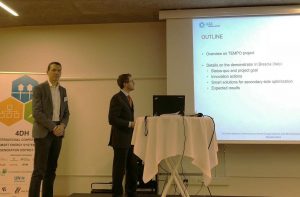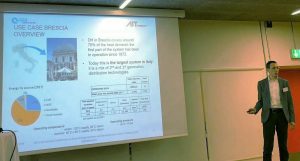The project results were presented in two sessions by VITO, AIT and A2A in Aalborg
 The 4DH Strategic Research Centre, the RE-INVEST project and Aalborg University invited researchers and experts from industry and businesses to the 4th International Conference on Smart Energy Systems and 4th Generation District Heating. This year’s conference took place from 13-14 November 2018 in Aalborg. With more than 130 interesting presentations, high-profile keynote speakers, exciting workshops and technical tours, the conference received a high level of interest. This year, the event hosted 320 participants representing 27 different Countries. The aim of the conference was to present and discuss scientific findings and industrial experiences related to the subject of Smart Energy Systems based on renewable energy and future 4th Generation District Heating Technologies and Systems (4GDH).
The 4DH Strategic Research Centre, the RE-INVEST project and Aalborg University invited researchers and experts from industry and businesses to the 4th International Conference on Smart Energy Systems and 4th Generation District Heating. This year’s conference took place from 13-14 November 2018 in Aalborg. With more than 130 interesting presentations, high-profile keynote speakers, exciting workshops and technical tours, the conference received a high level of interest. This year, the event hosted 320 participants representing 27 different Countries. The aim of the conference was to present and discuss scientific findings and industrial experiences related to the subject of Smart Energy Systems based on renewable energy and future 4th Generation District Heating Technologies and Systems (4GDH).
TEMPO project had a very good visibility with at least two sessions (4 and 23) dedicated to the initiative. During the session 4 Dirk Vanhoudt, researcher at VITO/Energyville (Belgium), provide the audience with a complete overview of the project objectives and results through the presentation entitled “Technological Solutions to Reduce District Heating Network Temperatures“. After introducing the benefits of a Low Temperature Network and the possible solutions to get this results, Mr. Vanhoudt started to present TEMPO. Its technological innovations and the related solution packages were showcased along with some short descriptions of the three demo sites.

A second session was dedicated to the TEMPO outcomes, namely the session 23, presented by Alessandro Capretti, Head of District Heating Network Planning and Design at A2A (Italy) and Paolo Leoni, researcher at the AIT Austrian Institute of Technology. Their intervention focused on the “Challenges and opportunities for lowering the temperatures in the District Heating Network” in Brescia (Italy), one of the three demo sites of TEMPO. The A2A network demo is the unique existing and working site at the moment within the project and the it is producing interesting results. The aim is always the same: to reduce the network temperature and make the solutions replicable along with an increased customers’ engagement. Mr Capretti outlined the present features of the Brescia’s network, underlining the main constraints concerning the lowering of the temperature. The main aim of the presentation was to demonstrate how the TEMPO solutions, applied to the network, can effectively decrease the temperature also through an optimization of the entire system. The consortium is expecting an increased efficiency of the network of about +25% in peak time and +30% in off-peak time, by a combination of fault detection tools, customers’ engagement, DSM and T minimization and (Self-learning) diagnostics tool of building-side faults.
